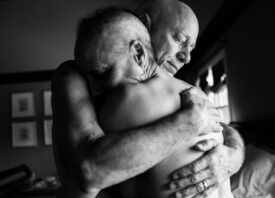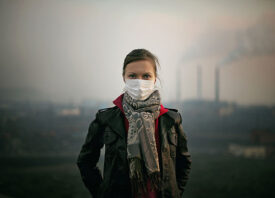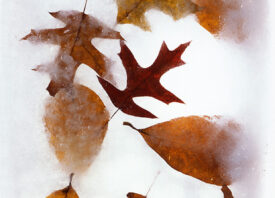Search this site
From Diagnosis to Healing: Turning a Cancer Journey Into a Powerful Visual Story

Yawning in the doctor’s office, melting ice cream, waiting in traffic, stolen kisses, bedtime rituals—these mundane, in-between moments took on new meaning in the wake of photographer Anna Rathkopf’s cancer diagnosis. When Anna was diagnosed at 37 with an aggressive form of breast cancer, she knew she wanted to document this time for her young son. Her husband and caregiver, Jordan Rathkopf, also started photographing, capturing their family’s cancer journey from his perspective.
The resulting book, HER2, is a moving and vulnerable portrait of a family offering an intimate and rarely-seen look at the “new normal” many cancer patients face: the emotional and everyday realities of life in the face of illness. Through images and stories shared by Anna, Jordan, and their child, the Rathkopfs’ invite viewers to witness the complexity of survivorship, vulnerability, and resilience.
“This book is a testament to our trauma, grief, resilience, hope, and the deep love that sustains us. It’s our
Anna Rathkopf
story, but not ours alone. Others have gone through their own experiences, but we are connected through feelings.”
Knowing their story is relatable and powerful for anyone who finds themselves or their family members in this situation, Jordan has since founded the Patient Caregiver Artist Coalition, a non-profit organization dedicated to fostering authenticity and inclusivity in how illness is portrayed. Together, the Rathkopfs’ share their impactful story—a testament to love, strength, and the profound humanity that can be found in the toughest of times.
How did photographing each other and yourselves help you process Anna’s cancer diagnosis and the subsequent journey?
ANNA: “The day after I was diagnosed with cancer, I made a decision to document our journey. I didn’t know how advanced my cancer was or whether I’d survive, but I felt an overwhelming need to create something for our son, Jesse—memories he could hold onto if I didn’t make it. Over time, that need evolved into something more: a way to reclaim my voice in a situation where I felt completely silenced and powerless.
“Cancer stripped away so much. I lost my confidence, felt betrayed by my body, and grieved the loss of my fertility. But through all the pain and uncertainty, my camera became my refuge. It gave me a way to process what I was feeling and share it when words weren’t enough.
“Photography wasn’t just about documenting what happened—it became part of my healing. It helped me start piecing myself back together, connecting the person I was before cancer, during it, and who I am now. It gave me space to feel seen, by myself and others, in a way I desperately needed. And it still is.”

JORDAN: “At first, photography was my lifeline. I didn’t know how to put my feelings into words, and I was afraid to say some of the things I was feeling. But art—photography, and music, in my case—gave me a way to process those emotions. It felt healing and natural.
“In the earliest days, I was focused on Anna and what was happening to our family. I didn’t really think about documenting myself or my own experience. It wasn’t until years later, seeing Anna’s self-portraits, that I felt inspired to turn the camera on myself. Her self-reflection made me realize I had neglected my sense of identity. Being a caregiver is incredibly hard, but it’s nothing compared to being the person diagnosed. That perspective made it difficult for me to give weight to my struggles. Photography has helped me reclaim a sense of self—it’s reminded me that my experience matters too.”

Your project “HER2” captures such intimate, raw moments. How did you decide which moments to include or exclude?
ANNA: “Choosing which photos to include and deciding how to tell our story was extremely difficult. Even though Jordan and I went through everything together, we each saw and felt things differently. We brought in others to help guide us and give an outside perspective, which made it easier to step back and make decisions, even when it was hard to let go of certain images. It was definitely a team effort, and in the process, we learned so much more about ourselves.
“This project brought us closer as a couple. Talking about how we felt during those moments in the photos opened up conversations that deepened our understanding of each other. I got to know Jordan on a whole new level.
“And through it all, we kept our son in mind—wanting the story to reflect not just what we went through, but how it shaped us as a family.”

JORDAN: “Some of my favorite images didn’t make it into the book because the sequence needed balance. Every image had to serve the larger story, not just stand out individually.
“The hardest part was narrowing the focus. We centered the story on our nuclear family—Anna, Jesse, and me—even though other events, like Anna’s mother’s stroke and cancer diagnosis or the loss of a close friend, profoundly impacted us. Ultimately, we wanted the narrative to stay anchored to Anna’s diagnosis and how it shaped our family even though there have been a lot of other things that have happened in the past years in addition to the aftermath of her diagnosis.”
What did you each learn about yourselves and each other through this project? Did any moments surprise you?
ANNA: “I remember one photo Jordan took of me. My first thought was, “Wow, he made me look so beautiful.” But it wasn’t about how I looked—I could feel his love for me in that photograph. He loved me even when I couldn’t love myself, and that’s something truly extraordinary. I’ll always be grateful for that.
“Working on this project also helped me see the love Jordan has for Jesse. There’s something so special about watching how he interacts with our son. Those little, everyday moments that might seem so small—they’re everything. Seeing that love through the lens has been such a gift.”
The mundane moments became everything when I got sick. Suddenly, nothing felt unimportant anymore because I didn’t know if I’d get to experience those small, ordinary things again. It gave me a new appreciation for all of it.
Anna Rathkopf

JORDAN: “Seeing Anna’s photographs gave me a completely new perspective on what she was going through. For years, I had been documenting her, but I came to realize that I was capturing my version of her experience—filtered through my perceptions of what she was feeling. Her images revealed layers of vulnerability, pain, grief, joy, and resilience that I hadn’t fully grasped.
“That realization forced me to confront the subjectivity of my lens—not just as a photographer, but as a partner. It was humbling to recognize how much I had been projecting my own narrative onto her experience. It taught me to approach both photography and my relationships with a greater sense of humility and deeper empathy.”

everything had changed for us in sitting inside that room.
Many people feel pressured to “stay positive” during their cancer journey. How did this expectation shape or conflict with your experience?
ANNA: “The pressure to “stay positive” was something I really struggled with. Suddenly, I was hyper-aware of all these images in movies and ads of women who were sick but still glowing, smiling, and strong. It felt like I was being smothered by this idea of how I was “supposed” to be. And sadly, those images influence how people think about illness. I remember people telling me I must be positive and I just didn’t get it. I heard that I might die, and they kept telling me to be positive about it. The images of women in perfect makeup felt like they were silencing me and everything I was actually feeling—grief, fear, and exhaustion.
“As a sick woman, there’s also this expectation to look a certain way—like those perfect heroines in perfectly ironed scarves, radiating strength. But I didn’t feel strong. I just wanted to survive. I wanted to be here for my two-year-old son, who was too young to even remember me if I didn’t make it. I wanted to be here.
“This constant push to be “positive” felt alienating. It made me feel like I couldn’t be honest about the harder parts of what I was going through, and that loneliness made everything even heavier.”

JORDAN: “That pressure shaped and, in some ways, still shapes so much of our experience. From the moment Anna was diagnosed, there was an expectation to appear fine or at least better than we may have felt. It was present at work, at home, and even in the hospital. After Anna entered survivorship, the expectation shifted again. We were supposed to feel grateful and move on, but the reality is far more complicated.
“While we are deeply grateful, we also live with the fear that cancer could return. Anna’s diagnosis was unexpected—she had no significant risk factors like age or family history—which makes it harder to feel secure. That pressure to project positivity often conflicts with the ongoing reality of living with uncertainty. “

Jordan often closed his eyes and took deep breaths, unaware he was doing so.
In what ways did the camera become a therapeutic or even empowering tool for you both?
ANNA: “For me, the camera became my companion. Every time I had a doctor’s appointment, I’d pack my camera, and just that act of packing made me feel like I was doing something for myself—not just sitting back and waiting for the results.
“The camera gave me a voice. It allowed me to express how it really felt—what words couldn’t capture. Through my images, I could show others the raw truth of those moments, and that became such an essential part of my healing process.”
JORDAN: “For me, the camera was both a shield and a magnifying glass. It allowed me to observe from a safe distance when things felt overwhelming, but it also helped me look closely at moments I might have otherwise avoided. It became a protective layer—a way to process without being completely exposed.
“At the same time, it was a time capsule. It preserved moments of love and joy that I never wanted to forget. The act of photographing gave me a sense of control and a way to hold onto hope.”

How has your understanding of vulnerability changed through your work on HER2?
ANNA: “I’ve come to realize that vulnerability allows for a deeper connection with others. By opening up and letting people into my inner world, I’ve found that it creates space for deep understanding and connection and can help others to open up as well. There doesn’t need to be shame in showing feelings—in fact, it’s through that honesty that I’ve been able to approach others meaningfully.
“I grew up in a family and culture (I am originally from the Czech Republic) where expressing emotions or talking about feelings was often seen as a sign of weakness. But what I’ve discovered is that the rawness and honesty in our work help me connect with others who feel unseen or misunderstood. It’s the vulnerability that invites them in and makes those connections possible.”
I am beginning to see vulnerability as a positive thing. I used to hide vulnerability because I saw it as a weakness.
Jordan Rathkopf
JORDAN: “When Anna got sick, I felt this need to be the problem-solver, the one who held everything together. But deep down, I was terrified and struggling deeply with managing my emotions and keeping up with my responsibilities.
“I had to confront my long-standing issues with anxiety and depression—issues I had ignored because I wanted to “man up” and project strength. Through this project, I’ve learned that being open and vulnerable doesn’t make you weak; it makes you human.”
Did documenting your experiences change how you approached or interacted with each other during this time?
ANNA: “Our decision to document our journey didn’t really change how we interacted, but it did open up new ways for us to connect. Sometimes, it would lead to laughter or start conversations, giving us the chance to talk about things we might not have otherwise.
“Taking photos of each other was just another way we could show our trust, letting us capture moments that were both vulnerable and meaningful to us.”
JORDAN: “It didn’t change my overall approach with Anna, but it did impact certain interactions—mainly for the better. Taking photos sometimes brought levity to difficult moments. Anna would see me fumbling with the camera to try and discreetly capture a moment, and she would start laughing.
“I was always mindful not to let the camera come before her. She was incredibly open and consented to allow me to capture her at all moments, but I did not want her to feel that documenting our lives was more important than her comfort and well-being. I think that balance allowed us to use photography as a tool for connection, not distraction.”

Were there particular visual themes or symbols that emerged repeatedly in your work?
ANNA: “Nature became something I had to capture. It helped me emotionally and connected me to my grandfather, a World War II vet who taught me how to garden as a child in Czechoslovakia. Only when I got sick, did I begin to understand that his gardening was how he dealt with his trauma.
“Then there was the constant presence of our son. He was always at the center of everything we did. Jordan and I were scared, but Jesse—he was the one leading us, like a light in a tunnel.”

JORDAN: “One of the most powerful themes in Anna’s work was the changing seasons. Her photographs captured the bittersweet emotions of those transitions—always layered and never rooted in just one feeling.
“Her images of Jesse were incredibly beautiful. Through her lens, I could see her profound love for him, the maternal bond, and how incredibly deeply connected they are.”

How do you navigate the emotional boundaries between your personal lives and the project when reviewing or sharing the work?
ANNA: “Balancing emotional boundaries is really hard. It is a process that we are still learning how to do.
“Our project is a part of our lives, as is cancer and my fears, and it is something that we need to learn how to live with and how to integrate into our lives.”
JORDAN: “I’m still learning. Sometimes, I feel like I’ve created emotional boundaries, but then something will remind me how deeply this work affects me. Sharing it—whether in a book, an exhibition, or a talk—can be more emotionally draining than I anticipate.
“When we share our story publicly, it can feel like we’re turning our lives into a narrative, which creates a strange sense of distance. At the same time, it brings us closer to others who connect with our experience. Balancing those emotions is an ongoing process.”

Has sharing your story opened doors to connecting with others in similar circumstances?
ANNA: “Absolutely, one hundred percent. We’ve been connecting with so many people, and every new connection reminds us how many of us are out there, facing similar struggles. The sense of community that’s developed has been incredible. It’s that sense of connection that keeps us going, knowing we’re not alone and that our story matters.”
JORDAN: “Absolutely. The best part of sharing our story has been the connections we’ve made with others. Every time I question whether we’ve shared too much, someone reaches out to say our experience resonates with them. Those moments remind us that we’re not alone.
“Sometimes, people tell us that our story has helped them, but I don’t think they realize how much it helps us to connect with them, feel seen, and get to see them, too.”

Do you view “HER2” as a finished story or an evolving visual diary?
ANNA: “We photographed during the treatment and a year after and after, and it never felt like we could just stop. When I hit the “five-year survival mark” and was told that I was being moved into survivorship and the doctors wouldn’t need to see me anymore, I felt abandoned and scared. That’s when I wanted to create something tangible, and that’s when we really started to talk about a book form. But my fear is not going anywhere and I just have to learn to live with that. So I would say that HER2 is a part of something larger, a way how to deal with trauma.”
JORDAN: “HER2 is a chapter of our lives, but it’s hard to call it finished because it’s so deeply tied to who we are and how we’ve grown. It represents a version of our experience—one shaped by where we are in our lives right now. Even within these first seven years, the meaning of certain images has shifted. Photos we took at the beginning now resonate differently, carrying layers we couldn’t have understood at the time.
“On days when I feel brave enough to think far ahead, I can imagine continuing this work for decades, letting it evolve as we do. But I’ve also learned to stay grounded in the present. It feels safer—maybe even a little superstitious—but for now, staying rooted helps me move forward.”
What has been the most rewarding part of telling this story together?
ANNA: “The most rewarding part of this whole journey is that we did it together, and even though it has not been easy to open up about so many aspects of what we went through, we are doing it. I learned so much about Jordan and the way how he sees the world now than I did before, and I felt I knew him very well.”
JORDAN: “The most rewarding part is being able to tell this story together. There were moments when I wasn’t sure if Anna would survive, and now, sharing our journey as a team reminds me of how much we’ve been there for each other.
“This experience hasn’t been without its challenges—there were cracks, and at times it felt overwhelming. But working through it together has strengthened our bond. It’s shown me that no matter how difficult life gets, we can rely on each other when it matters most.”
Talk to me about the Patient Caregiver Artist Coalition. What is your goal with this nonprofit?
ANNA: “Whenever I talk to other people how they feel about their illness or any other trauma, there is always this feeling of disconnection and loneliness, there is this way how to tell story that is so many times told by people who have no intimate connection to the subject and it shows. We want others to feel seen and have their voices heard through authentic experiences.”
JORDAN: “We started sharing our story because we didn’t see visuals that reflected what we were experiencing as a young family navigating illness. Most depictions felt too upbeat or too tragic. We didn’t feel seen, and when we began meeting others who felt the same, it encouraged us to keep going.
“The Patient Caregiver Artist Coalition is about creating a community of artists with lived experience of illness, injury, or disability. Our goal is to promote authentic, emotionally resonant depictions of patient and caregiver experiences while pointing toward tangible support for the community. We want to normalize real conversations about these issues—conversations driven by the people who have lived them.”

What do you hope readers take away from “HER2”?
ANNA: “I hope they feel less alone. Illness is messy, but there’s no “right” way to go through it.”
JORDAN: “I hope readers see that illness doesn’t exist in a vacuum—it impacts every aspect of our lives, our relationships, and the way we see ourselves. More than anything, I hope people feel less alone when they see this work.”



